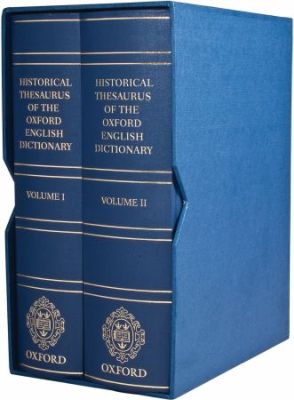Ett meningsmonument
 Det tog 45 år för dom, men nu fanimej är dom klara! Engelska-institutionen vid universitetet i Glasgow började 1965 med att sammanställa Historical Thesaurus of the Oxford English Dictionary, och nu kan de äntligen öppna champagnen, för att de två volymerna på 4448 sidor med över 800 000 ord (hela OED), fint ordnade i drygt 230 000 kategorier, med synonymer kronologiskt ordnade efter när de först började användas, finns äntligen att köpa i en välsorterad boklåda.
Det tog 45 år för dom, men nu fanimej är dom klara! Engelska-institutionen vid universitetet i Glasgow började 1965 med att sammanställa Historical Thesaurus of the Oxford English Dictionary, och nu kan de äntligen öppna champagnen, för att de två volymerna på 4448 sidor med över 800 000 ord (hela OED), fint ordnade i drygt 230 000 kategorier, med synonymer kronologiskt ordnade efter när de först började användas, finns äntligen att köpa i en välsorterad boklåda.BBC skriver:
The work was nearly destroyed in a fire in 1978, but despite the building being gutted, a metal filing cabinet protected the files. [...]
The thesaurus was nearly completed in 1980, but the team decided to include words from updated versions of the Oxford English Dictionary.
This added almost 30 years more work to the project.
Så här beskrivs upplägget, och det är något av ett manifest för en otidsenlig vilja till organisation:
The thesaurus organization follows a unique thematic system of classification, with entries arranged in a comprehensive semantic hierarchy according to their meanings. Each individual synonym is presented in chronological order according to the first recorded date of the word's use in English as listed in the Oxford English Dictionary, with earliest synonyms given first.Jason Kottke skriver:
There are three major sections in the HTOED, reflecting the main activities and preoccupations of users of the language:
I The external world
II The mental world
III The social world
These in turn are divided into 354 major categories, such as Food and drink, Thought, or War. Further categories and subcategories follow, moving from the most general ideas to the most specific. Overall, the HTOED contains around 800,000 meanings, organized into more than 236,000 categories and subcategories.
The semantic categories and subcategories are headed by phrases which define them and link to preceding sections. In the abridged example given here, the headings and numbering show that Terms of endearment, at the fourth level of the semantic hierarchy, are part of Love,Emotion, which in turn comes under The mind.
02 The mind
....
02.02 Emotion
....
02.02.22 Love
....
02.02.22.04 Terms of endearment
....
The HTOED contains obsolete, historical, and archaic vocabulary, as well as the vocabulary of current English; it covers scientific, technical, and specialist terminology as well as slang, dialect, and informal language, and regional varieties of English from all parts of the world. Each term is precisely entered into its place in this comprehensive hierarchy of meaning, according to its meaning and date, and is accessible either by browsing at any level of the hierarchy, or by looking up a particular word in its alphabetical place via the Index.
I like that the synonyms are listed chronologically but this thing is crying out to be put online (or in some electronic format)...what a boon it would be for period novelists to able to press the "write like they did in 1856" button.Ännu mer, hur skulle det gå om man satte internet på det här problemet? Alltså ge alla ord mening genom att "precisely enter them into their place in a comprehensive hierarchy of meaning"? Om man bortser från alla praktiska problem, hur lång tid skulle det ta, och hur "korrekt" (jämfört med med HTOED) skulle det bli? Jag tänker att den här webbskaliga övningen skulle kunna spridas ut i form av Gwap-liknande spel, där användarna får ett eller flera ord som man sedan ska välja en plats i hierarkin för. Det blir ju lite av ett röstningssystem också. Kan kanske bli svårt det här...
[via: The Long Now]
kommentar(er)
| www.flickr.com |
Jag heter Erik Stattin och det här är min blogg. Jag skriver om digital kultur, ungefär. Du får gärna tipsa mig om saker. Kontakta mig på erik.stattin@gmail.com. Jag är mymarkup på Twitter och Delicious.